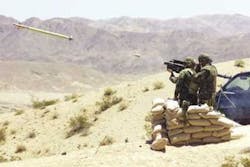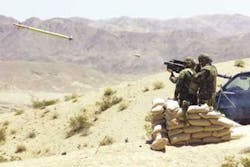By John McHale
PEABODY, Mass. — Engineers at Analogic Corp. in Peabody, Mass., and Sanders Design International (SDI) of Wilton, N.H., have joined hands to develop infrared countermeasures (IRCM) to protect commercial airliners from shoulder-fired heat-seeking missiles such as the U.S. Stinger and Russian SA-18.
The two companies recently received funding from the U.S. Air Force and the Defense Advanced Research Programs Agency (DARPA) in Arlington, Va., to further develop their Spatial Infrared CounterMeasure (SICM) self-protection system for commercial airliners and military aircraft.
While no missile attacks have been reported against jetliners in the U.S., it is a lot easier than the public may believe to smuggle these weapons into the states, says Eric Bailey, vice president of CT engineering, Computed Tomography Systems at Analogic.
null
Experts say that about 6,800 U.S. commercial aircraft are vulnerable to IR guided missiles during aircraft approach, landing, and takeoff at altitudes below 15,000 feet.
The need to protect commercial airliners from such attacks became an immediate concern late last year after suspected terrorists armed with IR missiles tried to shoot down an Israeli airliner in Africa.
Then early this year U.S. lawmakers introduced the "Commercial Airline Missile Defense Act" in the U.S. House and Senate. This legislation, if enacted, would require all commercial aircraft to have automatic IRCM systems to counter IR missiles.
Shoulder-fired missiles made the headlines again last month when a British man was arrested for trying to smuggle surface-to-air missiles into the U.S.
Military systems designers traditionally have looked for countermeasures that confuse incoming missiles either with flares that create false targets, or with lasers that create a cocoon of heat around the missile warhead to throw off its tracking system, Bailey explains.
SDI designers have come up with a somewhat different concept that basically can fool a missile's tracking system into believing an aircraft is standing still when it is actually moving or vice versa. It is similar to the optical illusions at sports stadiums when thousands of fans get up to do the wave, Bailey continues. From far away it looks like one continuous moving wave, when it is really not, he explains. Bailey declined to go into specifics on the technology.
"Based upon proven technology and simulations, this infrared countermeasures invention causes missiles to miss the intended aircraft by a safe distance," says Analogic Chairman Bernard Gordon. Gordon also says that at Analogic's request a major aerospace company has already carefully reviewed and tested the design concept.
The concept came from a team led by Roy Sanders, chairman of SDI. Sanders was a founder and the namesake of Sanders Associates, which began in Waltham, Mass., in 1951 and moved to Nashua, N.H. in 1952. Today that company is the Information & Electronic Warfare Systems sector of BAE Systems North America.
"The low-cost IRCM system offers potentially 'near perfect protection' against single or multiple simultaneously launched IR missiles at a small fraction of the cost for currently available IRCM systems valued at one million dollars or more per aircraft," Sanders says. "The projected reliability of the system is within standard maintenance periods and serviceable by airline ground personnel."
The IRCM does not require aircraft technicians to install a lot of extra hardware to the exterior of the plane, and the pilot can control the system similarly to the way he controls the aircraft's outside lights, Bailey says. Most of the complicated programming for the device is in firmware, he adds.
"Our infrared technology, coupled with Analogic's extensive knowledge of signal and image processing and control, and their considerable manufacturing experience, provides the basis for a successful team approach to this technological challenge," Sanders adds.
SDI originally was awarded a small business innovative research project contract to develop the technology.
The Transportation Security Working Group under the Transportation Security Administration also recently selected SDI, working with Analogic, as a semi-finalist for participation in full-scale IRCM system development contracts, which will be awarded later this year.
For more information on Sanders Design International contact the company on the World Wide Web at http://www.sandersdesign.com/. For more information on Analogic contact the company on online at http://www.analogic.com.




